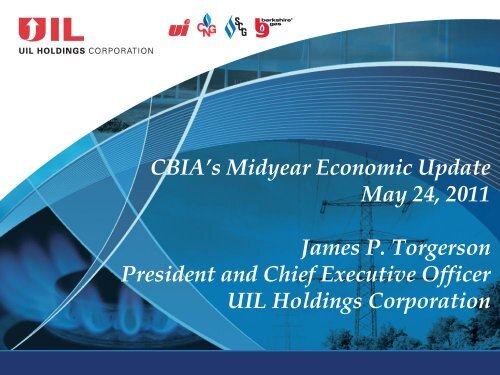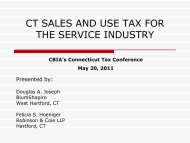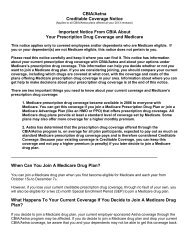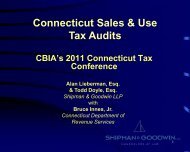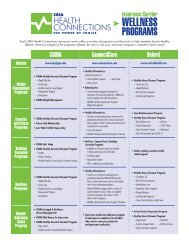James P. Torgerson, President and CEO UIL Holdings ... - CBIA
James P. Torgerson, President and CEO UIL Holdings ... - CBIA
James P. Torgerson, President and CEO UIL Holdings ... - CBIA
You also want an ePaper? Increase the reach of your titles
YUMPU automatically turns print PDFs into web optimized ePapers that Google loves.
<strong>CBIA</strong>’s Midyear Economic UpdateMay 24, 2011<strong>James</strong> P. <strong>Torgerson</strong><strong>President</strong> <strong>and</strong> Chief Executive Officer<strong>UIL</strong> <strong>Holdings</strong> Corporation1<strong>CBIA</strong> – May 2011
OverviewBrief Overview of <strong>UIL</strong> State of Business in Connecticut Regional Institute for the 21 st Century Questions <strong>and</strong> Answers2<strong>CBIA</strong> – May 2011
<strong>UIL</strong> – Corporate Structure, Service AreasConnecticut<strong>UIL</strong> <strong>Holdings</strong>CorporationBerkshire GasConn. Natural GasSouthern Conn. GasThe United Illuminating Co.Western MassachusettsThe United IlluminatingCompany (UI)Southern Connecticut Gas(SCG)Connecticut Natural Gas(CNG)Berkshire Gas Company(Berkshire)› Service territory: 335 sqmiles› ~325,000 customers› 1,095 employees› Allowed Distribution ROEof 8.75%› Earned ’10 TransmissionROE (composite) of 12.5%› 50% interest in GenConnEnergy LLC› Service territory: 512 sqmiles from Westport, CT toOld Saybrook, CT› ~178,000 customers› 290 employees› 2,269 miles of mains with~131,000 services› 2009 rate case allowed ROEof 9.26% (1)› Service territory: 716 sqmiles - Greater Hartford-New Britain & Greenwich› ~160,000 customers› 319 employees› 2,011 miles of mains with~124,000 services› 2009 rate case allowed ROEof 9.31% (1)› Service territory: 738 sqmiles in Western MAincluding Pittsfield <strong>and</strong>North Adams› ~36,000 customers› 120 employees› 738 miles of mains› Allowed ROE of 10.50%Note: (1) Includes 10 basis point penalty reduction. Previously authorized 10.0% & 10.1% at SCG & CNG respectively, in effect pending approval of settlement agreement.<strong>CBIA</strong> – May 20113
<strong>UIL</strong> Transformation Announced Agreement in May 2010 to purchase three gas localdistribution companies from Iberdrola, USA for $1.3 billion.Completed transaction within 6 months – November 16, 2010. Transformed <strong>UIL</strong> into a diversified energy services company. Strategic transaction that was important for Connecticut jobs <strong>and</strong>business in the state. One of the largest corporate deals in 2010 completed in Connecticut.<strong>UIL</strong> Becomes A Stronger, More Diverse Energy Company4<strong>CBIA</strong> – May 2011
Electric <strong>and</strong> Natural Gas SegmentsCapitalize on the competitive advantage of natural gas as theeconomical, abundant <strong>and</strong> environmentally friendly fuel of choice forcustomers.Aggressively pursue new gas heating customers.Generate incremental revenue sufficient to support exp<strong>and</strong>inginfrastructure.5<strong>CBIA</strong> – May 2011
Potential for Gas Heating in CTAmerican Community Survey’s selected housing characteristics estimates show a large percentage ofhouseholds in Connecticut do not use natural gas for heatingConnecticut15%50%31%Litchfield (0) Hartford (20) Toll<strong>and</strong> (6)Windham4% 5%2% 1%5%4%4%8%13%16%13%11%41%13% 62%9%9%67%42%68%73,704 339,516 52,993 42,653(0)2% 1% New Haven# Occupiedhousing units:1,327,482The # in parentheses representsthe number of cities or towns inthat county that are served by a<strong>UIL</strong> Gas Company.Fairfield2% 1%15%(9)47%35%325,920MiddlesexNew London(11)4% 3% 4% 3% (3)2% 2% (13)18%19%11% 63%63%16%11%46%35%65,476104,468322,752Fuel oil, keroseneUtility gasElectricityBottled, tank or LP gasOther¹Approximately 37% of businesses & households on <strong>UIL</strong> gas mains are not currently natural gas customersSource: U.S. Census Bureau; Average data for 2005-20091Other includes coal or coke, wood, solar, no fuel used <strong>and</strong> other6<strong>CBIA</strong> – May 2011
Natural GasNatural GasLow Cost Alternative – Currently about half price of oil.Plentiful Supply$ 1.71 per gal equivalent for natural gas$ 4.03 for home heating oil*Environmentally friendly <strong>and</strong> domestic.Generate incremental revenue sufficient to support exp<strong>and</strong>inginfrastructure.Public concerns about hydraulic fracturing (Known as fracking).*State of Connecticut RESIDENTIAL HEATING OIL AND PROPANE PRICE SURVEY (04/25/2011),as reported by the State of Connecticut Office of Policy <strong>and</strong> Management<strong>CBIA</strong> – May 20117
Natural GasMap of Shale Gas Basins in North AmericaSource: Gastem.caIf Drilling Is Done Appropriately…It is Safe.8<strong>CBIA</strong> – May 2011
20062005200420032002200120001999199819971996199519941993199219911990198919881987198619851984198319821981198019791978197719761975197419731972197119701969196819671966Electric OperationsAggressive $2.1B UI base capital expenditure plan for 2010-2019.Replacement of aging infrastructure critical.Aging Infrastructure –Historic Investment40,000Arab Oil Embargo SeabrookRestructuring4000030,000Replacement Cost3000020,0002000010,000Installed Cost10000009<strong>CBIA</strong> – May 2011
($M)Near-Term Average Rate Base ProfileRate Base (Excluding GenConn Equity Investments):$2,250$2,000$1,780$1,806$1,750$1,500$751 42% $766$1,250$1,000 $127 7% $89$750$405 23% $403$1,954$78043%$505%$42522%40%2%22%$500$250 $497 28% $548 30%$699 36%$2,128$2,215$2,309$853$827$802 38%38%37%$11 1%$499$532$517 23%23%23%$816 38% $871 39% $924 40%$02010A 2011P 2012P 2013P 2014P 2015PElectric distribution Electric transmissionCTA Gas distribution*RATE BASE IS GROWING TO PROVIDE SAFE, RELIABLE SERVICE* 2010 Gas distribution average rate base reflects the full year; <strong>UIL</strong> ownership was for 6 weeks effective with the closing on the acquisition. For comparability purposes, Gas distributionexcludes the impacts of 338(h)(10) election.<strong>CBIA</strong> – May 2011Amounts may not add due to rounding.10
UI Transmission – NEEWS InvestmentUI Participation in CL&P Project:‣ UI’s portion of investment: greater of$60M* or 8.4% of CL&P’s costs for theCT portions …› Greater Springfield ReliabilityProject› Interstate Reliability Project› Central CT Reliability Project‣ UI deposits through May 5, 2011 -$7.9M› Remaining investments expectedto be made over a period of 3 to 5years* NU recently informed UI that it will be revising its costs estimate for the CT portion of theses projects. UI will update it projected investment once therevised estimate is provided by NU.11<strong>CBIA</strong> – May 2011
Electric OperationsAbility to attract capital is critical for growth <strong>and</strong> system reliability.UI has the lowest allowed ROE (return on equity) in the country.12<strong>CBIA</strong> – May 2011
State of BusinessConnecticut has a rich history with vast neighborhoods full of character.However, challenges exist with its approach toward business. Escalating taxes <strong>and</strong> structural challenges are at the core of thedilemma. Frequent investor questions about the anti-business climate in thestate.Regulatory environment under constant scrutiny.13<strong>CBIA</strong> – May 2011
Best/Worst States For BusinessSource: Chief Executive Officer MagazineTop Ten14<strong>CBIA</strong> – May 2011
Best/Worst States For BusinessBottom TenSource: Chief Executive Officer MagazineConnecticut – Ranked 44th15<strong>CBIA</strong> – May 2011
State of BusinessWhat are we doing to help fix the situation? We can become business competitive again. Framework for structural challenges in many areas areknown <strong>and</strong> outlined. New leadership can drive effective change.16<strong>CBIA</strong> – May 2011
Regional Institute For The 21 st CenturyWhat is CT21?The Connecticut Regional Institutefor the 21 st Century was formed in1997 when public <strong>and</strong> privateleaders in Connecticut cametogether to exchange ideas aboutincreasing the state’s economicgrowth.The group focuses on informingpolicymakers on key issues thathold the most potential for thestate’s future. Managed by astatewide steering committee, theinstitute provides continuingopportunities to discuss <strong>and</strong> studyimportant issues regardingConnecticut competitiveness.17<strong>CBIA</strong> – May 2011
Regional Institute For The 21 st CenturyThe Institute’s Current MissionThe Institute has resolved to look at elements of spending thataccount for a significant percentage of the state’s budget <strong>and</strong>where shifts in approaches to service delivery could make a realdifference.In doing so, the Institute engaged research firm Blum Shapiro toassist in this effort, asking them to review major budgetaryprogram areas in the State.18<strong>CBIA</strong> – May 2011
Regional Institute For The 21 st CenturyConnecticut Regional Institute for the 21 st Century 2010 recent studies: Assessment of Long Term Care System Assessment of CT’s Correction, Parole <strong>and</strong> Probation System Pensions <strong>and</strong> Other Post Employment Benefits: How Does CT Compare?Studies were commissioned <strong>and</strong> completed in 2010. Presented findings to the public, elected officials <strong>and</strong> communityleadership. Evaluate <strong>and</strong> monitor progress.New study coming mid-late 2011 – “Delivering Public Services at theRight Scale”19<strong>CBIA</strong> – May 2011
Regional Institute For The 21 st CenturyASSESSMENT OF LONG TERM CARE SYSTEM Long term care is broad <strong>and</strong> affects everyone. Connecticut Medicaid expenditures on long term care are significant.Spending will increase by more than $3 billion by 2025.The number of people over 65 years of age will increase by 40%(207,745), due to aging of the Baby Boomers Generation.20<strong>CBIA</strong> – May 2011
Regional Institute For The 21 st CenturyASSESSMENT OF LONG TERM CARE SYSTEM UConn study determined nearly 80% of people would prefer to remainat home with health care services delivered there.Home <strong>and</strong> Community Based Care is about half the cost of institutionalcare.Not all recipients need 24/7 care of an institution.Rebalancing to the stated objective of the State can deliver savings. CT Initiative – Money Follows the Person15 CT Agencies currently have a role in determining Medicaid waivers21<strong>CBIA</strong> – May 2011
Regional Institute For The 21 st CenturyASSESSMENT OF LONG TERM CARE SYSTEMSample Recommendations Provide Strong LeadershipLegislative actionGovernor must make Long-Term Care a priority Create a strategy <strong>and</strong> align the long term care systemOrganization StructureClearly defined goalsProcess <strong>and</strong> TechnologyMeasurement <strong>and</strong> Accountability Consolidate <strong>and</strong> integrate CT long term care functionsEstablish consolidated human services approach for all agesCreate a statewide Single Point of EntryLegislation pending22<strong>CBIA</strong> – May 2011
STATE OF BUSINESSAssessment of Connecticut’s Correction, Parole <strong>and</strong> Probation Connecticut’s prison growth has not been caused by growth in crimerates. Prison growth has been caused by policy choices. We anticipate that although the prison population in the state will continuedownwards, it will move at a much slower rate than in the recent past <strong>and</strong> willstabilize.23<strong>CBIA</strong> – May 2011
STATE OF BUSINESSAssessment of Connecticut’s Correction, Parole <strong>and</strong> ProbationSample Recommendations Creation of a Criminal Justice Policy Advisory Committee. (CJPAC)Creation of statewide Re-Entry Strategy Include the business communityEstablish a Faith/Character-Based pilot initiative within the incarceratedmale populationDevelop a comprehensive information systemRe-negotiate union contracts24<strong>CBIA</strong> – May 2011
STATE OF BUSINESSPublic Employee Plan Funding Connecticut’s unfunded Pension <strong>and</strong> Medical liability is $41.878billion. This represents a liability of $17,480 for every voting age citizenin Connecticut.Our total annual required contribution (ARC) to the pension <strong>and</strong>medical plans is $2.968 billion per year or 12% of current state budget.Our review identified 19 broadly defined actions that are best practices<strong>and</strong> can be considered in CT. For Connecticut, there is no explicit constitutional protection for publicpension benefits. Statutory protection exists for vested employees whosatisfy eligibility requirements by becoming eligible to receive benefits.25<strong>CBIA</strong> – May 2011
Public Employee Plan FundingSTATE OF BUSINESSRecommendations Connecticut should consider whether to implement a definedcontribution arrangement for future participants. Currently the Stateonly has a Defined Benefit (DB) plan.States with DC or Hybrid PlansAlaskaDC Thirteen states now offer DC-type plansas a part of their retirement benefits. Connecticut must put new measures in placeto manage medical benefits. Changes ineligibility, employee contributions, etc.ColoradoGeorgiaFloridaIndianaMichiganMontanaNebraskaNorth DakotaOhioOregonSouth CarolinaWashingtonDB/DC ChoiceHybridDB/DC ChoiceHybridDCDB/DC ChoiceHybridDB/DC ChoiceDB/DC ChoiceHybridDB/DC ChoiceHybrid26<strong>CBIA</strong> – May 2011
Recent Action- State of Connecticut <strong>and</strong> SEBACRecommended by CT211. Require contributions to medicalcoverage costs.2. Implement managed care <strong>and</strong> wellnessprograms.3. Increase the age at which employees areeligible to retire with full benefits.4. Bring early retirement benefits in linewith market rates <strong>and</strong> relevantequivalents of normal retirement.Accepted1. All employees to begin paying ½% to 3%per year to the Retiree Healthcare TrustFund – No new increase in sharingcurrent costs.2. Boost preventive care plan <strong>and</strong> new costsfor br<strong>and</strong> name drugs <strong>and</strong> emergencyroom visits.3. 3 year increase starting in 2022.4. Early retirement subsidy reduced from6% to 3%. Premium sharing increasesfor early retirees.5. Eliminate COLAS.5. COLAS will use same formula, butminimum goes from 2.5% to 2.6. Change averaging period from 3 to 5years for retirement calculation.276. Final average earnings computationbased on 5 yrs for some new hires.<strong>CBIA</strong> – May 2011
In ClosingCT Regional Institute <strong>and</strong> <strong>CBIA</strong> arehaving an impact. Progress has been made but muchmore work to be done. Bold leadership <strong>and</strong> structural changes are necessary forCT’s future health <strong>and</strong> business competitiveness.28<strong>CBIA</strong> – May 2011
Q&A29<strong>CBIA</strong> – May 2011


